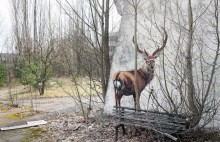The wall of a building in Prypiat features a picture of a mother bear with a cub. Next to it, one can see a graffiti of a deer family. These are almost all animals which we were able to see in the exclusion zone, except for butterflies and other insects and a black woodpecker that overflew us at a great altitude. However, scientists working in the exclusion zone say you can encounter many animal species there, including Red List ones. Their words are confirmed by the data obtained from camera traps.
“After the accident, the natural environment of the exclusion zone has changed greatly, and for the better. Lack of humans and their economic activity has led to the restoration of the Polissia’s natural systems, typical for this area in the 17th-18th centuries,” Denys Vyshnevskyi told us; he is head of the radiation-ecological monitoring group at the Ekotsentr Specialized State Enterprise. Vyshnevskyi has been working in the exclusion zone for 16 years. In his opinion, the best way to use this area is through creating a natural reserve-like institution for the preservation and study of local biodiversity.
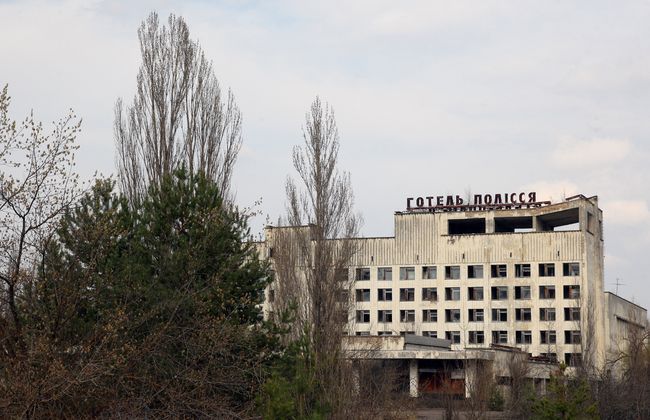
This is exactly what was done past year. On April 26, 2016, President Petro Poroshenko signed a decree creating the Chornobyl Radiation-Ecological Biosphere Reserve. Paperwork was done over the year, and the institution was finally registered on March 30. Having visited the exclusion zone, The Day has learned what interesting experiences it will offer to visitors, and in what direction the area next to the reactor is being transformed.
EVERYTHING WILL BE FOREST!
Reporters surrounded Vyshnevskyi in the center of the soccer field in the stadium at Prypiat. This place looks more like a neglected park alley now. “When the city of Prypiat was founded, vegetation was almost absent here. Now it is overgrown with quick-growing trees: maples, poplars, birches. They, and not thermonuclear weapons, will erase cities from the face of Earth when people will disappear there. These plants cause bio-demolition. They take root on the roofs and foundations, and break up cement and concrete structures while growing. Some buildings have collapsed already in Prypiat, and some exhibit clear signs of this process at work,” the scientist said.
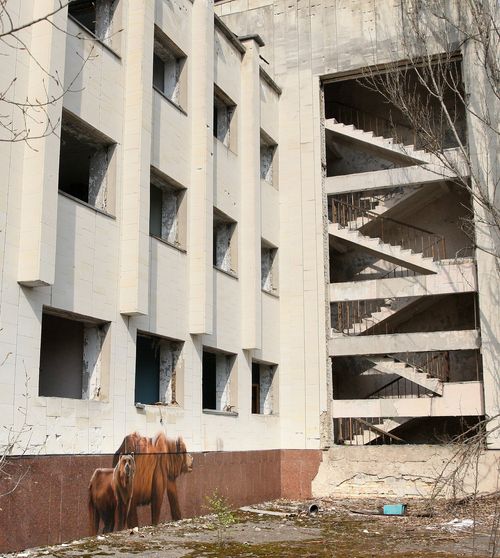
Cultivated plants do, of course, change in the absence of humans, but they do not necessarily go extinct. For instance, roses turned into dog roses and tea roses, the latter coming in white and pink colors. Vyshnevskyi recalled: “One year in the third decade of April, I came to the village of Cherevach [evacuated due to contamination after the Chornobyl nuclear accident. – Author] and approached a house where people had last dwelt a long time ago. Its walls had slumped, the roof had collapsed, but I saw a very beautiful row of daffodils in front of the window. Tulips and daffodils bloom every spring, although there is no one left to admire them.”
The accident’s impact on vegetation was at its worst in 1986, I mean the so-called Red Forest, which died then due to the release of radioactive dust. “We have not noticed obvious adverse changes in vegetation cover in other parts of the exclusion zone,” Vyshnevskyi continued. “There are cases related to other factors. For instance, we had pines dying lately in the Red Forest, one after flooding, and another after a wildfire.”
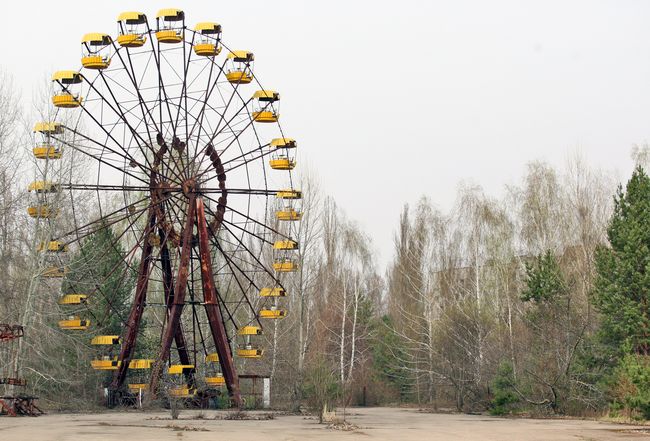
Overall, 70 percent of the exclusion zone is forested. The wildfire of 2013 damaged 15,000 hectares there. This year, the forest regeneration work will be done on 400 hectares of the exclusion zone. People will plant more than 1.5 million seedlings on 197 hectares, mostly pines. The rest of the area will get assistance to naturally occurring forest regeneration.
The Red List plants of the exclusion zone which scientists have identified include many orchid species. Serhii Hashchak, who serves as deputy director for research at the International Radioecological Laboratory and head of radioecology research department at the Chornobyl Center on Nuclear Safety, Radioactive Waste and Radiology, explained: “Some years, these plants even fail to appear on the surface. They may appear as rarely as one year out of ten, and it is great if a scientist sees it. Perhaps the lack of cattle trampling, plowing and chemical treatment of the soil contributed in part to them beginning to explore more territory in the zone.”
THE RETURN OF THE LYNX
Five-tailed Chornobyl wolves and two-headed wild boars live on only in tall tales. “Immediately after the accident, its consequences manifested as death, disease, impaired reproduction and development of animals. However, most organisms which were impacted in their vital functions died so early that scientists were only rarely able to study them. Generally speaking, not much is known about the first years after the accident. Now, if one looks for some visible effects, we have some trees, such as pines and birches, with impaired development of needles and branches,” Hashchak said.
He first came to the exclusion zone in 1986 and has worked there since 1990. He has handled thousands of mice as well as a lot of birds and frogs. It seems that only once did he encounter an animal that clearly had a problem, when he caught a mouse stricken with cancer of the sternum. “Others were normal – externally, I mean. But when scientists examine blood, genes, tissues of an animal, it displays a wide range of different effects. They do not always lead to death, but do create some problems,” the radioecologist continued. “Organisms live under stress and deal with it. Some adapt to it. However, so far, no evidence has surfaced of organisms with unique resistance to radiation emerging. Rather, inherent properties of the cells come to the surface.”
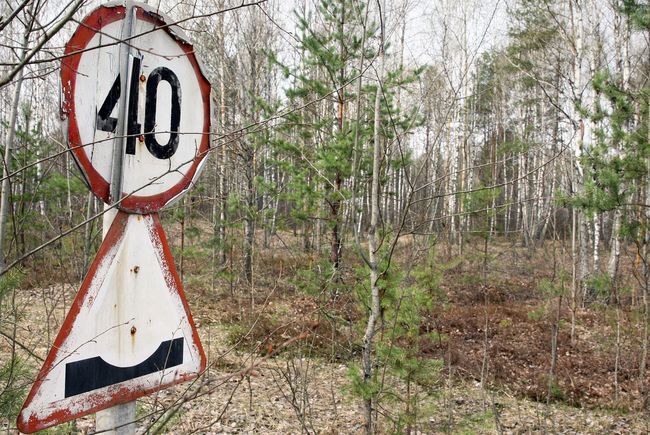
Over several decades that have passed since the accident, the exclusion zone has become home to animals that were last seen there many decades or even centuries ago. For example, the lynx has returned after virtually disappearing from the area in the mid-20th century. According to Hashchak, scientists started registering these animals’ presence in the early 1990s. In the mid-1990s, footprints of a lynx were seen even in the Red Forest. As many as 21 camera traps have been installed here, in one of the most contaminated sites, by now, and over half of the observation points have registered both younglings and adult specimens of these predators.
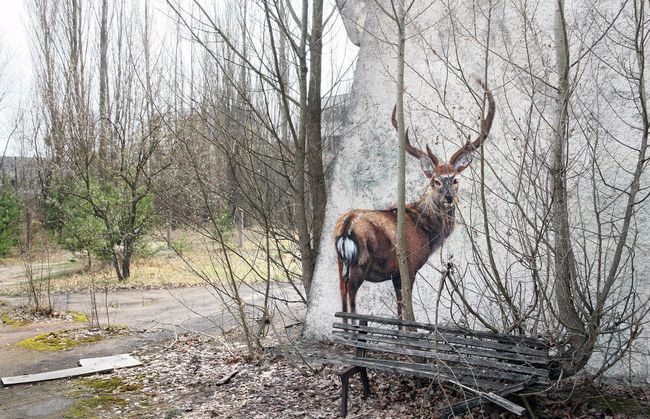
Those working in the exclusion zone encounter mostly wild pigs. They are numerous and have almost no fear of humans. Vyshnevskyi saw a wolf on three occasions, as five to seven families of these predators live in the zone. Red deer, elk, and roe deer are comparatively well-represented, with around 600 individuals of each species living there. All these are background species for the area.
Speaking of the Red List animals, the black stork was seen in the zone, although it is unlikely to nest there. Other rare species include the smooth snake, white-tailed eagle, two varieties of spotted eagle (one of them, the great spotted eagle, being rare all over Europe), gray crane, black grouse, hazel grouse. Owls, eagle-owls, and the Eurasian pygmy owl have been seen in the area as well. “Most of the Red List species were present in the area before the accident, they just were far less numerous,” Hashchak stated. “Over the past 25 years, when human pressure on wildlife decreased, they have become free of constraints and begun to occupy all suitable habitats.”
Olena Burdo, a junior research fellow at the Institute for Nuclear Research of the National Academy of Sciences of Ukraine, has studied since 2008 populations of murine rodents living in the Chornobyl exclusion zone. “The main result of our study is that 30 years later, we are still seeing the effects that can be classified as caused by ionizing radiation. It is likely that they will be observed in the future as well. These effects operate at the levels of bone marrow cells, organs etc. They are indiscernible morphologically,” Burdo emphasized.
PRZEWALSKI’S HORSES ARE EXPANDING INTO THICKETS
Przewalski’s horses were brought to the exclusion zone in 1998. The introduction was part of the free-living population program, developed by experts from the Askania Nova Reserve. It aimed to establish a free-living population of this species.

Horses have acclimated well, although it is hard to keep tabs on them. There were 27 individuals in the exclusion zone in 1999, and about 60 in 2013. “There are definitely more than 50 of them here now, but probably less than 100,” Vyshnevskyi remarked. “When the horses were first brought here, there were two large herds, and we counted them every quarter. They have split in many small herds since. When the question arose in 2003, how many horses were there, we counted them from a helicopter. When moving by car, you see only a little, since the area is just too large. No accurate count of the horses was done for four years. I have the impression that we have been undercounting these animals all the time. Having inspected one herd recently, I counted three foals and two pregnant mares among them. That is, breeding intensity is quite high.” By the way, even though this species’ natural habitat is desert or semi-desert, the Przewalski’s horses are expanding into forests in the exclusion zone.
VISITOR NUMBERS ARE GROWING, AND NO CONSTRAINTS WILL BE PUT ON PUBLIC INTEREST
The exclusion zone, which is an area of 30 kilometer radius around the Chornobyl Nuclear Power Plant, will be divided in two. Vitalii Petruk, head of the State Agency of Ukraine on Exclusion Zone Management (SAEZ), hopes that the inner area, stretching for almost 10 kilometers around the plant, will be legally established as a special industrial zone. “It will be involved in efforts to improve the current strategy for radioactive waste management and host solar panel installations [part of the Chornobyl Solar project. – Author],” Petruk said. The rest of the area, amounting to two thirds of the exclusion zone, will comprise the abovementioned Chornobyl Radiation-Ecological Biosphere Reserve.
The reserve was registered on March 30 this year, marking the starting point after which it can be organized on the ground. Taras Melnychuk, who is the acting chief manager of the Chornobyl Reserve, is now forming its administration. The institution’s budget and establishment are also being drafted, and zoning has to be developed for it as well.
“We still need to make many amendments to the legislation. There is a law on the legal regime in the exclusion zone, whose main purpose is to enable it to perform the barrier function, that is, to stop spread of radionuclides outside the area. The purpose of the reserve is slightly different, so there is a conflict of laws here,” Petruk remarked. Meanwhile, Melnychuk added that the reserve would essentially work under the transitional administration this year which would focus on enabling the institution to become fully functional in 2018.
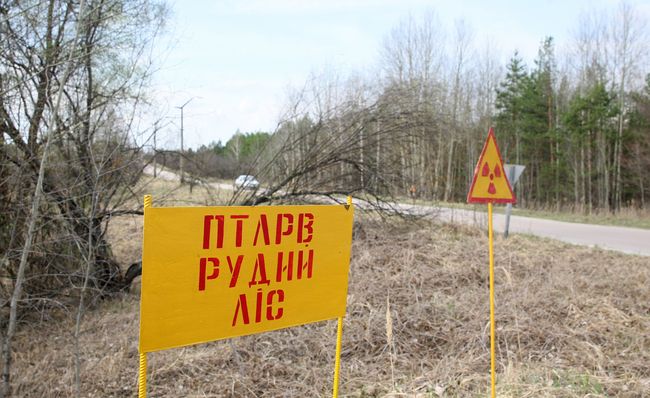
As always, money is in short supply. The SAEZ’s budget request for 2017 was set at 110 million hryvnias, the sum deemed to be necessary to get the reserve running. The Ministry of Finance has allocated just 5 million, or 22 times less. Petruk’s request for next year will be set according to the needs again. Perhaps the Ministry of Finance will become more generous once the institution’s functions get outlined more clearly.
The reserve will concentrate its efforts on science. In fact, the exclusion zone is already open for research, but the new status will make international cooperation and dealings with donors more comfortable. By the way, a joint project with the Japanese Fukushima University, held under the SATREPS International Research Program, will begin this May. It will involve 12 Ukrainian and a number of Japanese research institutions.
Another question, of interest to many people, is that of simplified access to the exclusion zone. Everything has remained as it was before the reserve’s creation so far, because it was created within the exclusion zone, and its legal status has not changed yet. “Maybe something will change in the future. We will focus on stricter controls in the special industrial zone later,” Petruk commented.
By the way, the number of visitors in the exclusion zone has doubled in 2016 compared to 2015, with more than 32,000 guests instead of about 16,000. The head of the SAEZ concludes: “The public interest in the area is there, and we are not going to constrain it.”
The exclusion zone is a site of a terrible disaster that has become a subject of research and a unique “pilgrimage” attraction for visitors from around the world. Also, it is a great example of how quickly nature forgets about people, and how much it thrives without them.

